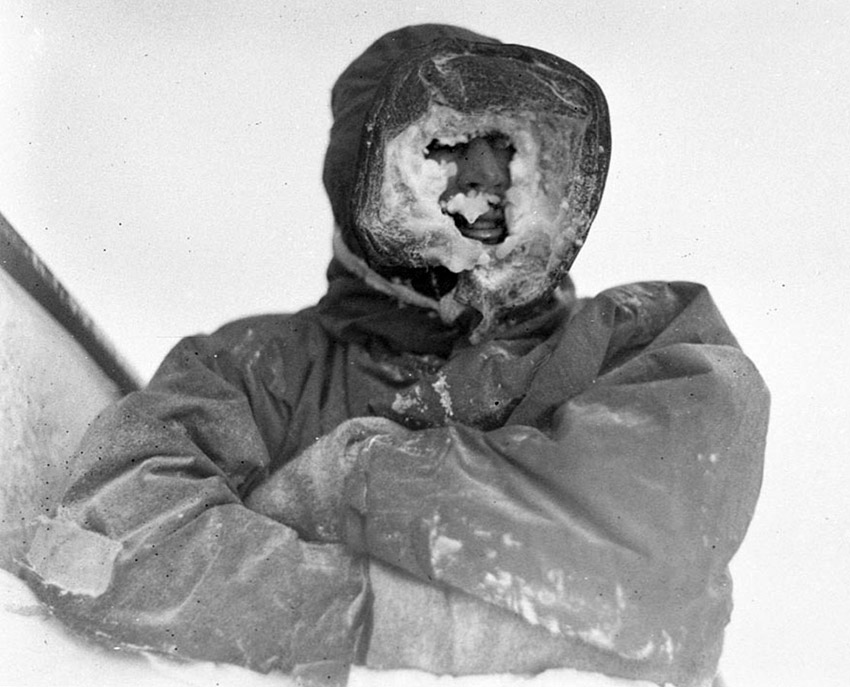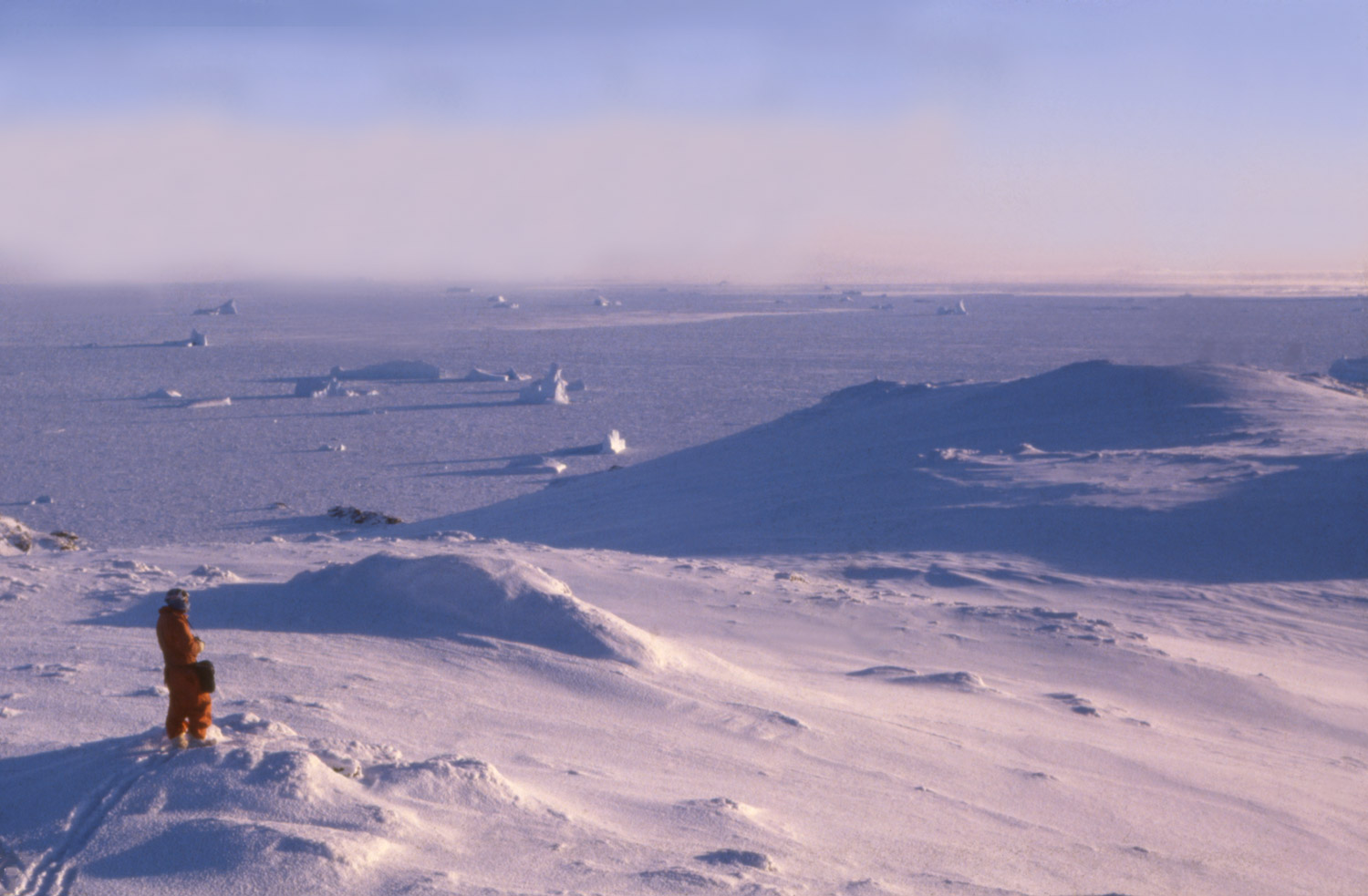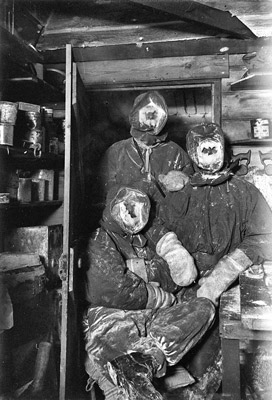Cold Weather and Health - How do cold temperatures affect
health and well being?
The dangers of cold
The effects of cold weather on health, how the human body responds to low temperatures and the effects of winter. Your health can be affected for good or ill depending on your response to the different aspects of winter.
Clothing for Cold Wintery Weather: Dressing for the Cold | Winter Coats | Winter Tops | Winter Bottoms/Pants | Winter Underwear | Winter Hats | Winter Gloves | Antarctic Boots | Cold Weather Work Wear | Stylish Winter Clothing | Kids Winter Clothing | Kids Winter Coats
Cold Effects
Cold temperatures place physiological stresses on the body, the more healthy and fit you are, the more easily your body can cope with these stresses. Dressing properly is the key to being healthy in a cold climate. Avoiding undue stresses particularly if you are not seasonally acclimatized to the cold is also important, especially in the very old, the very young and those with an underlying health condition all of whom should have the home heated to at least 18C (64F).
Eat well or lose weight - One of the best ways to stay warm in a cold climate is by the use of the "inner furnace" to generate heat from within. While salad might be just the thing you want in the warmth of summer, come the colder months of the year, it's hearty stews, soups and comfort food that just doesn't do the same thing for your palate in warmer weather. This is your body's way of telling you it needs more fuel to keep warm. If you can put up with constantly feeling cold, this is a possible way of losing weight.
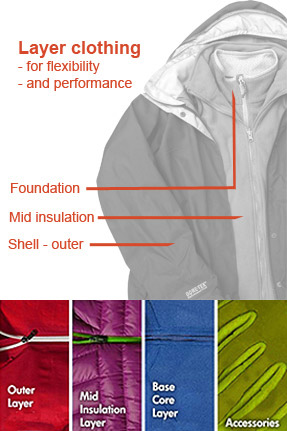 Use
layers to stay warm, - The layer principle
of dressing should be used in cold weather, this doesn't
mean simply lots of layers, but layers for particular purposes,
a close fitting base layer to wick away sweat, especially if
there is any physical exertion taking place, insulating mid
layers and a looser fitting wind or waterproof outer layer.
Insulation can be provided by a number of thinner layers rather
than a single thick layer. This is a more effective way of staying
warm as air (the real insulator) is trapped between as well
as within the layers.
Use
layers to stay warm, - The layer principle
of dressing should be used in cold weather, this doesn't
mean simply lots of layers, but layers for particular purposes,
a close fitting base layer to wick away sweat, especially if
there is any physical exertion taking place, insulating mid
layers and a looser fitting wind or waterproof outer layer.
Insulation can be provided by a number of thinner layers rather
than a single thick layer. This is a more effective way of staying
warm as air (the real insulator) is trapped between as well
as within the layers.
It also results in less cumbersome dressing overall increasing mobility and is more flexible in that layers can be added or removed as conditions change. Zips, draw cords and closeable cuffs all help to loosen up during exertion and fasten up again when resting or if it gets colder. clothing for extreme cold
Am I cold because I feel cold? - How cold you feel and how cold you are, are not as closely related as you may imagine. While uncontrollable shivering is under the influence of your subconscious and indicates a fall in the core temperature, how cold you feel is not a great indicator. Some people are able to tolerate the cold more than others largely on the basis of perceiving exactly the same sensations in a different way. You can train yourself to be less affected by the cold, more on cold acclimation and acclimatization here.
As people get older, they can become less perceptive of cold temperatures, another reason the elderly are more prone to becoming hypothermic, they just don't notice their falling body temperature.
Why do I want to pee when it's cold? - When you are cold your body reduces the circulation to the extremities and skin surface, a process called peripheral vasoconstriction (peripheral = at the edges, vaso = blood vessels) so concentrating a greater volume of blood in the body core. This increases the arterial blood pressure. The body's response is to try to reduce this pressure, the kidneys reduce the volume of circulating blood by removing water to the bladder to be lost as urine. This process is known as "cold diuresis" (diuresis = the production of copious watery urine).
On return to a warmer environment, circulation is restored to the periphery which reduces the volume circulating in the core, which triggers a thirst sensation so you drink, go outside in the cold again.. etc. etc.
Feeling cold all the time is a common symptom of a number of medical conditions such as:
- Anemia - Caused by a lack of iron in
the diet or an inability to make enough red blood cells.
If you are female of reproductive age and vegetarian it
is even more likely.
- Hypothyroidism - Most often caused
by an autoimmune disorder, most frequently in women and
in or approaching middle age.
- Raynaud's disease - A situation
where spasms in the arteries in the hands and feet result
in a lack of blood flow to the fingers and toes which go
pale and numb.
- Diabetes - one symptom of "diabetic
nephropathy" the kidney damage resulting from diabetes
is a feeling of being cold all the time.
- Anorexia - people with this eating disorder often feel cold all the time as the body tries to make any nutrition last as long as possible by generating less heat. Soft body hair often grows as a response to being cold as added insulation to counter the loss of naturally insulating body fat.
A constant feeling of being cold can be a sign of a more serious medical condition, if you really can't ever get warm even in a warm place or long after coming in from the cold, you should contact a doctor.
Physical risks from the cold directly
Slips and trips - Obvious but less interesting than the other threats from the cold, though far and away the largest threat in terms of casualties. Bruises, cuts and broken bones are common along with sprains and strains. The lower back and head are most often injured along with arms and hands as people attempt to break their fall.
Normal footwear in icy conditions just isn't good enough, overshoes or grips of some kind, or boots with an aggressive tread pattern are what is needed and even then you can't just go skipping along over icy areas and expect to stay upright.
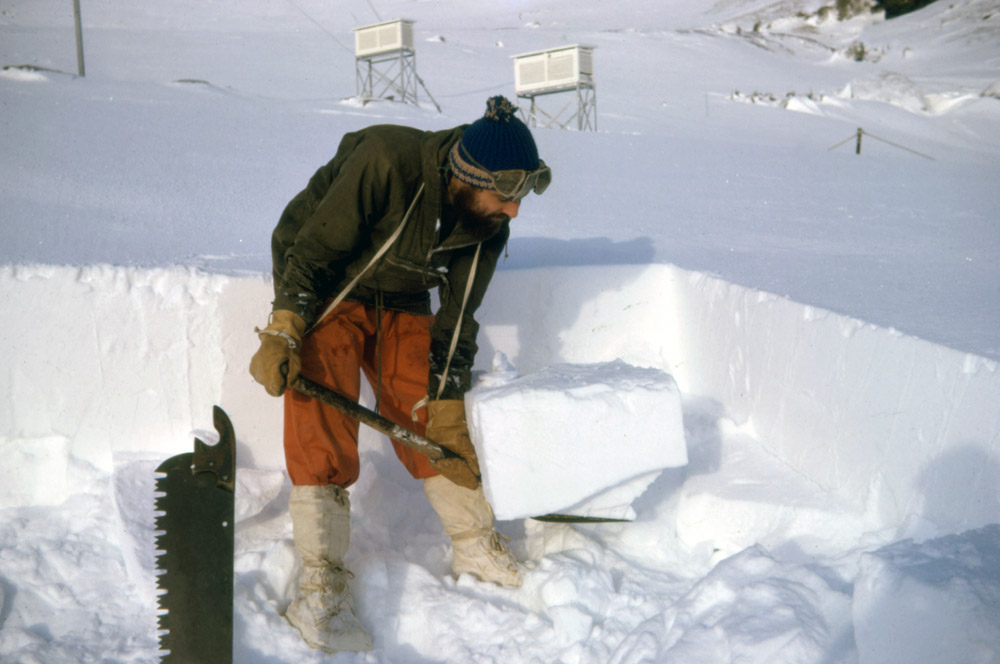 Heart attacks
- These increase in frequency during the winter months usually
affecting those who already have an underlying health problem.
A drop in temperature concentrates blood flow in the body core,
increasing blood pressure so placing more strain on the heart,
also your body works harder to generate additional heat when
it is cold.
Heart attacks
- These increase in frequency during the winter months usually
affecting those who already have an underlying health problem.
A drop in temperature concentrates blood flow in the body core,
increasing blood pressure so placing more strain on the heart,
also your body works harder to generate additional heat when
it is cold.
People at risk should keep warm at all times, in
the home including in bed and wrapping up well with hat, scarf
and gloves before going out. Those 10-20 minutes at
the start of a journey where much of it may be spent walking
or standing waiting for a bus or train in the cold can tip the
balance and trigger a heart attack, it is important to wrap
up BEFORE you go out, not to set off loosely
done up and then react to the feeling of cold later. Early morning
is the most hazardous time due to natural daily rhythms, so
prepare for your winter commute.
If you combine cold temperatures with physical exertion in those who are susceptible, then the likelihood of a heart attack increases even further. Around 100 people a year are reported to die while shoveling snow for instance in the USA alone, while some estimate the real figure could be double that, hospital visits for the same reason are over 10,000 per year!
The rise in heart rate and blood pressure with activity along with the effect of cold in constricting arteries to reduce blood supply is particularly dangerous to older people (over 55), those who have heart or circulatory disease and are unfit with a sedentary lifestyle unaccustomed to vigorous exercise. The answer? Take it easy, push rather than lift the snow, buy a snow-blower, get someone else to do it, or just don't do it if you don't have to.
Frost nip and frost bite - Both of these handily descriptive conditions can physically damage bits of your body. Frost nip happens when part of your body becomes so cold that the blood flow slows because that area is losing too much heat and is starting to be sacrificed (yes you should be worried by this prospect!). It can be identified because that area of skin becomes a very un-natural pale colour as there is little or no blood passing through it.
The nose, ears, cheeks, fingers and toes are first affected. It is not so easy to spot in yourself, so you should watch for it in your companions and you should all be made aware and know to look out for it. If you spot frost nip, then the affected area should be warmed up with a gently placed glove or similar - don't rub! - this can damage already fragile cells. If spotted quickly frost nip can be dealt with easily, the effects are readily revisable and not permanent. If not spotted in time it may lead to:
 Frost bite
- a more serious situation where ice crystals form inside body
cells killing them in the process. Superficial frostbite is
recoverable though can be intensely painful whereas deep frostbite
can lead to the loss of fingers, toes and even parts of limbs.
Make sure you watch for frost nip and do something about it
immediately. If you suspect frostbite move to somewhere warmer
if possible and seek medical attention immediately,
don't rub!
Frost bite
- a more serious situation where ice crystals form inside body
cells killing them in the process. Superficial frostbite is
recoverable though can be intensely painful whereas deep frostbite
can lead to the loss of fingers, toes and even parts of limbs.
Make sure you watch for frost nip and do something about it
immediately. If you suspect frostbite move to somewhere warmer
if possible and seek medical attention immediately,
don't rub!Hypothermia - A serious situation (to the point of potential fatality) where the temperature of the body core falls from what it should be at 37C to 35C or less. You have probably spotted that this is not much of a drop. Your body will let you know this is happening with plenty of warning from shivering, numb extremities, reduced dexterity and just feeling miserably cold. The response should be to warm up, put more clothes on or go indoors. A fall in core temperature of 1C will slow reaction times and impair judgment. More on hypothermia.
Immersion foot / trench foot - Usually associated with the trenches in the First World War from where the condition gained its common name, though the Korean War and American Civil War had many cases too. It occurs when the feet are wet for long periods of time in conjunction with temperatures below 10C. Rarely encountered outside of warfare situations, though may occur in the homeless in wintery conditions.
-
Jan 23rd 1912:
Re-organised the sledge at lunch, set the sail and were
going at a great pace until Wilson noticed Evans nose was
white and hard with frostbite.
Captain Scott
Disease risks associated with cold
Cold diminishes the immune response - Cold weather results in less blood supply to the extremities in order to preserve body heat in the core of the torso and head. This reduction in blood flow means there are fewer white blood cells available to fight disease. It seems that the body initially at least reacts to cold temperatures as a short term risk whereby today compromises are made in order to be fit to live tomorrow. This effect seems to result in an increased susceptibility to winter illnesses such as colds.

Colds and flu - colds and flu are NOT caused by cold weather, they are caused by viral infections of the upper respiratory tract that you catch from others. The longest cold-free time of my life was the two continuous years I spent in Antarctica.
Why colds and flu are more prevalent in the winter months is not fully known though behaviour has an effect, we are more likely to be indoors with other people and ventilation is likely to be worse than when it is warmer. The immune system is depressed to some degree by cold weather which particularly affects the upper respiratory tract which cools down when cold air is breathed in. A cold nose gives cold and flu causing rhinoviruses more opportunities to reproduce, so you are more likely to catch a cold if one is around if the temperature is cold. In warmer temperatures, the immune system is more likely to intercept the viruses before they can result in an illness. Covering the nose with a scarf or balaclava to keep it warm is an effective way of reducing the chances of catching a cold.
The common cold is the most prevalent human disease with adults getting 2-5 colds a year, for children this rate is doubled and it is up to twelve a year for school age children. It seems to be spread mainly by touch of contaminated surfaces, though air-borne infection is also important, the virus can then often be taken into the body by rubbing the eyes or touching the face. There are no actual cures for the common cold, flu or viral sore throats. Any remedies are about alleviating the symptoms until the immune system can remove the infection. In fact in the case of the common cold, it is the immune system itself that causes the symptoms as it changes internal body conditions to favour white blood cells to be able to fight the infective viruses more effectively.
Influenza or flu is a similar infection to the common cold but much more serious. It is a major killer of the elderly and infirm, especially those with long term illnesses such as kidney disease or diabetes. infection routes are as for colds. Annual "flu jabs" against the most prevalent strain that year are recommended for the most vulnerable groups.
Sore throats - Also almost always caused by viruses and transmitted in a similar manner to colds and flu.
Norovirus - The "winter vomiting bug" as it is often known. Like colds, this can affect people at any time of the year, though is most prevalent in the winter months. It can particularly affect semi-closed public areas such as schools, hotels and cruise liners. An unpleasant and very infectious stomach bug that causes sickness and diarrhoea though is usually over within a couple of days.
Asthma - Cold air is a particular trigger of asthma attacks, the only ways to avoid this are to avoid the cold air by staying indoors or by wearing a scarf over the mouth so that very cold air is not breathed in so quickly. Breathing though the nose rather than the mouth helps to warm the air up too.
Winter risks, not necessarily cold related
Depression and SAD (Seasonal Affective Disorder) - A condition that may affect people as a result of shorter day length in the winter months. Unsurprisingly this is independent of temperature, though perhaps more surprisingly it isn't particularly related to the amount of day light experienced. You might expect people in more extreme latitudes to suffer more than those closer to the equator but it seems not to be the case, there is no correlation with winter day length other than the obvious underlying seasonality.
The condition can be addressed by getting out more in the
day light, sitting near to a window or by using an artificial
light box. The mechanism is unknown other than it is light related.
The health benefits of cold weather
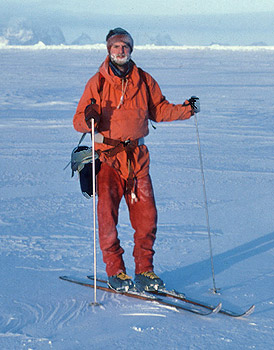 Reduction
in disease carrying organisms - biting
flies in particular disappear when the temperature drops. It
doesn't need to be extreme cold that has the effect, even
relatively mild winters limit the range of the kinds of organisms
that spread diseases such as malaria, sleeping sickness (trypanosomiasis)
and bilharzia (schistosomiasis) three of the world's commonest,
deadliest and most debilitating diseases.
Reduction
in disease carrying organisms - biting
flies in particular disappear when the temperature drops. It
doesn't need to be extreme cold that has the effect, even
relatively mild winters limit the range of the kinds of organisms
that spread diseases such as malaria, sleeping sickness (trypanosomiasis)
and bilharzia (schistosomiasis) three of the world's commonest,
deadliest and most debilitating diseases.
The biggest positive health effect of cold weather is to limit the spread of infectious diseases (and there are many more than just these three), we tend not to notice this, you are more likely to notice the cold you got than the life threatening bout of malaria or trypanosomiasis avoided.
Lack of pollen - plants don't make pollen in the winter in general, so it can't get up your nose and in your eyes to cause hay fever and allergic reactions to it.
Burning body fat - colder temperatures mean you burn more calories to stay warm. This would work to lose weight if you ate the same amount, except we tend not to. So of theoretical interest only other than for the hair-shirted who are happy (or able to tolerate) feeling cold most of the time.
Picture credits, copyright pictures used by permission: Snowblocking - A.D. Bailey

